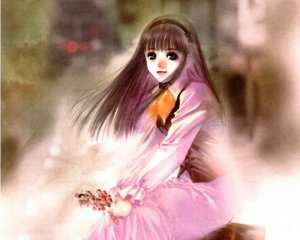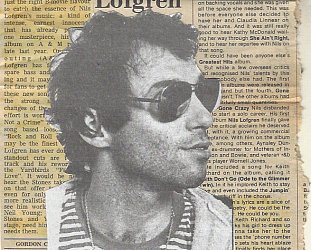Graham Reid | | 4 min read
Kyary Pamyu Pamyu: PonPonPon

Like French pop, the mainstream pop music of Japan is largely a mystery to outsiders. If so much French pop is breathy or more like an innocous soundtrack to high-end visuals, Japanese pop can seem like cliches come to life.
And J-pop works in an enclosed world. Japan and Korea were the only countries last year to have their end-of-year top 10 album sales made up entirely of local artists.
In other words, "big in Japan" is no joke. Especially if you are a Japanese artist because Japan is the second largest music market in the world.
Japan is also one of the few countries where physical CDs remain the format of choice, odd in such a hi-tech country that digital downloads lag far behind the "old" format of compact discs.
Last year wasn't a great one however, sales fell by almost 17 percent while in the rest of the world (largely driven by digital sales), notably Europe and the US, climbed.
But if you are bored with US and British acts, you could do worse than turn to Japan because the artists are so . . .
Well . . .
The Japanese boy bands are so identikit that they used to arrive and disappear with alarming regularity and you didn't notice the difference between them being here or gone. Long serving bands like Glay -- who have sold around 25 million albums since the late Eighties -- are rare in a world infatutated with "idol singers" whose lifespan isn't much longer than that of a mayfly.
And the girl pop singers are often so relentlessly chirpy and made-up like dolls that it all seems like a children's show where the wardrobe mistress has been dropping acid in a fantasy factory.
The rather good Pink Lady only lasted about two years in the late Seventies despite huge hits then tried to get traction in the US. Didn't happen.
There is a loud metal scene, massive rap demographic and so on, but it is the pure pop of Japan which is so fascinating and, to outsiders, hilariously good fun.
You doubt it? Check the clip below by current star Kyary Pamyu Pamyu, a model turned pop singer whose rise to fame was so dramatic she wrote her autobiography at 18.
At 21, this star (born Kiriko Takemura) is an emblem of the absurdly cute Harajuku look which is doubtless her appeal to children, but doesn't quite explain why late teens and even adults have taken to her.
 She is a fashion statement and the line blurs between her pop songs and their use in ads.
She is a fashion statement and the line blurs between her pop songs and their use in ads.
She's a product but she's also smart, has about two million Twitter followers and sometimes mixes grotesque make-up with that adorable girly-girly look.
Yep, it's bewildering to outsiders . . . but of course makes perfect sense if you've ever watched J-pop television shows or wandered through the dress-up wonderland that is Harajuku.
 That concept of dressing up called Visual Kei (its practioners are visualists) and has been popular with Japanese rock bands since the Eighties . . . which, in reverse, explains why Kiss look like some 14-year old manga-obsessed Japanese boy's idea of a hard rock group.
That concept of dressing up called Visual Kei (its practioners are visualists) and has been popular with Japanese rock bands since the Eighties . . . which, in reverse, explains why Kiss look like some 14-year old manga-obsessed Japanese boy's idea of a hard rock group.
But the idea of dressing up has frequently appeared in Japanese society. In this book by Peter Carey, one of the author's friends explains how in the 1600s young men began appearing big cities wearing "fuck you clothes" and "reading about them they seemed exactly like punks", except their protest was to wear short kimonos. They were called Kabuki Mono which meant deviant, crooked or licentious.
The pop look of today isn't like that of course (although hints of the same innocence/sexualisation of young girls which is familiar from manga and Japanese porn movies is certainly part of contemporary video.
This pure pop stuff -- which can of course be analysed seriously as many have done -- is enjoyable for its disposability and oddball clips.
Just start your viewing experience here and see how far you can last without feeling the need to brush all that sugar and candy off your teeth.
And that's just Kyary (whom I was put onto by a six-year old I should tell you) who is part wind-up doll, part Bjork (in strange appearance, not the music) and all colour.
 She can also, in photos, look exactly like a panel out of a manga comic, which in its own way is something of a gift. And enhances her appeal to manga-fans. It also allows for those codes from manga to resonate across, and in the clip below she does actually become a manga caricature of herself.
She can also, in photos, look exactly like a panel out of a manga comic, which in its own way is something of a gift. And enhances her appeal to manga-fans. It also allows for those codes from manga to resonate across, and in the clip below she does actually become a manga caricature of herself.
This is a very superficial look at Japanese pop music culture and Kyary Pamyu Pamyu's place in it, just for pleasure.
Those rock bands are a study on their own as is the Japanese underground, and there is fun to be had trying to decode some of the band's names.
Thee Michelle Gun Elephant took their name from a friend mispronouncing the Damned's Machine Gun Etiquette.
My favourite rock single however is one I picked up on minidisc many years ago which has pride of place in my office. It is by the famous outsider rocker (and lowercase) hide who committed suicide in '98 aged 33.
It is called Hurry Go Round, which is funny enough in itself.
But it is the band name that gets me every time: Spread Beaver.
For other articles etc on various types of Japanese music and culture and travel go here and here.
.





Ross Middleton - May 26, 2015
Yes, all very droll. I did mean to comment when this piece was first put up so better late than never. J-pop is truly a gigantic and many-hued beast which can take itself very, very seriously. For those interested, Jpopsuki TV is a good place to start. My all-time favourite song is Jun Shibata's Miseinen. The accompanying video, at this link, is also fabulous. http://www.jpopsuki.tv/video/Jun-Shibata---Miseinen/5c2237a38700cb8eaabbffcb220ffdb7 Just love the highly emotive water theme in the video and the swirling discordant orchestral climax to the song, a la MacArthur Park, is something else. As Graham suggests, it's cliche central. GRAHAM REPLIES: Ross is right, the clip is great but it did take a wee while (a minute or so) for it to load, so be patient.
Savepost a comment